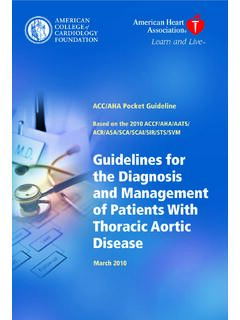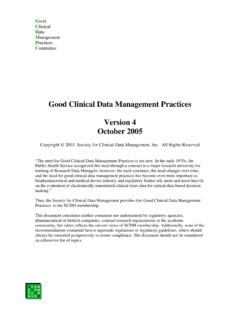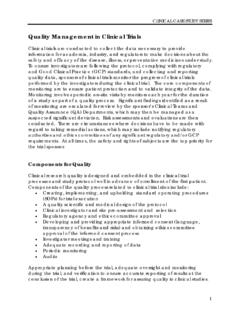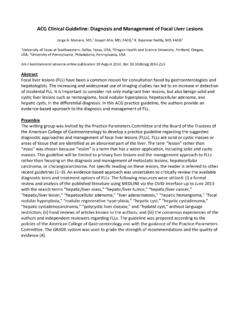Transcription of 2018 Guideline on the Management of Blood Cholesterol
1 2018 Guideline on the Management of Blood CholesterolGUIDELINES MADE SIMPLEA Selection of Tables and FiguresUpdated June 2019, American College of Cardiology B19146A report of the American College of Cardiology/American Heart Association Task Force on clinical Practice GuidelinesCITATION: J Am Coll Cardiol. Nov 2018; DOI: M. Grundy, MD, PhD, FAHA, ChairNeil J. Stone, MD, FACC, FAHA, Vice Chair Alison L. Bailey, MD, FACC, FAACVPRC raig Beam, CREKim K. Birtcher, MS, PharmD, AACC, FNLAR oger S. Blumenthal, MD, FACC, FAHA, FNLAL ynne T. Braun, PhD, CNP, FAHA, FPCNA, FNLAS arah de Ferranti, MD, MPHJ oseph Faiella-Tommasino, PhD, PA-CDaniel E.
2 Forman, MD, FAHAR onald Goldberg, MDPaul A. Heidenreich, MD, MS, FACC, FAHAMark A. Hlatky, MD, FACC, FAHAD aniel W. Jones, MD, FAHAD onald Lloyd-Jones, MD, SCM, FACC, FAHAN uria Lopez-Pajares, MD, MPHC hiadi E. Ndumele, MD, PhD, FAHACarl E. Orringer, MD, FACC, FNLAC armen A. Peralta, MD, MASJ oseph J. Saseen, PharmD, FNLA, FAHAS idney C. Smith, Jr, MD, MACC, FAHAL aurence Sperling, MD, FACC, FAHA, FASPCS alim S. Virani, MD, PhD, FACC, FAHAJ oseph Yeboah, MD, MS, FACC, FAHAW riting Committee:The purpose of the present Guideline is to address the practical Management of patients with high Blood Cholesterol and related disorders. The 2018 Cholesterol Guideline is a full revision of the 2013 ACC/AHA Guideline on the Treatment of Blood Cholesterol to Reduce Atherosclerotic Cardiovascular Risk in Adults.
3 The following resource contains tables and figures from the 2018 Guideline for the Management of Blood Cholesterol . The resource is only an excerpt from the Guideline and the full publication should be reviewed for more tables and figures as well as important context. 2018 Guideline on the Management of Blood CholesterolGUIDELINES MADE SIMPLETop Ten Messages to Reduce Risk of ASCVD ..4-6 ACC JACC Central Illustration: Overview of Primary and Secondary ASCVD Prevention ..7 Four Statin Benefit Groups: 1. Secondary ASCVD Prevention - clinical ASCVD: Figure 1 .. 8 - Criteria for Very High Risk ASCVD.
4 9 2. Severe Hypercholesterolemia (LDL-C 190) - Recommendations for Primary Severe Hypercholesterolemia [LDL-C 190 mg/dL ( mmol/L)] .. 10 3. Diabetes Mellitus in Adults 40-75 Years of Age With LDL- C 70-189 mg/dL - Risk Enhancers That Are Independent of Other Risk Factors in Diabetes .. 11 4. Primary Prevention Over the Life Span - Primary Prevention: Figure 2 .. 12 - Risk-enhancing Factors for Clinician-Patient Risk Discussion .. 13 - Checklist for Clinician-Patient Shared Decision Making for Initiating Therapy.
5 14 - Selected Examples of Candidates for Coronary Artery Calcium Who Might Benefit from Knowing CAC=0 (In Selected patients if Risk Decision Uncertain) .. 15 Treatment Considerations: High-, Moderate-, and Low-Intensity Statin Therapy .. 16 Statin Associated Side Effects (SASS) ..17-18 Special Populations: Normal and Abnormal Lipid Values in 19 Ethnicity Issues in Evaluation, Risk Decisions, and Treatment of ASCVD Risk ..20-22 Selected Table or Figure Page2018 Guideline on the Management of Blood CholesterolGUIDELINES MADE SIMPLEGUIDELINES MADE SIMPLE 2018 Guideline on the Management of Blood CholesterolChol4 Back to Table of ContentsTop 10 Take-Home Messages to Reduce Risk of Atherosclerotic Cardiovascular Disease (ASCVD) through Cholesterol Management (1 of 3)A healthy lifestyle reduces atherosclerotic cardiovascular disease (ASCVD) risk at all ages.
6 In younger individuals, healthy lifestyle can reduce development of risk factors and is the foundation of ASCVD risk reduction. In young adults 20 to 39 years of age, an assessment of lifetime risk facilitates the clinician patient risk discussion (see #6) and emphasizes intensive lifestyle efforts. In all age groups, lifestyle therapy is the primary intervention for metabolic syndrome. 1In all individuals, emphasize heart-healthy lifestyle across the life-course. The more LDL-C is reduced on statin therapy, the greater will be subsequent risk reduction. Use a maximally tolerated statin to lower LDL-C levels by 50%. 2In patients with clinical ASCVD, reduce low-density lipoprotein Cholesterol (LDL-C) with high-intensity statin therapy or maximally tolerated statin therapy Very high-risk includes a history of multiple major ASCVD events or 1 major ASCVD event and multiple high-risk conditions.
7 In very high-risk ASCVD patients, it is reasonable to add ezetimibe to maximally tolerated statin therapy when the LDL-C level remains 70 mg/dL ( mmol/L). In patients at very high risk whose LDL-C level remains 70 mg/dL ( mmol/L) on maximally tolerated statin and ezetimibe therapy, adding a PCSK9 inhibitor is rea-sonable, although the long-term safety (>3 years) is uncertain and cost effectiveness is low at mid-2018 list very high-risk ASCVD, use a LDL-C threshold of 70 mg/dL ( mmol/L) to consider addition of nonstatins to statin therapy. If the LDL-C level remains 100 mg/dL ( mmol/L), adding ezetimibe is reasonable. If the LDL-C level on statin plus ezetimibe remains 100 mg/dL ( mmol/L) and the patient has multiple factors that increase subsequent risk of ASCVD events, a PCSK9 inhibitor may be considered, although the long-term safety (>3 years) is uncertain and economic value is uncertain at mid-2018 list patients with severe primary hypercholesterolemia (LDL-C level 190 mg/dL [ mmol/L]), without calculating 10-year ASCVD risk, begin high-intensity statin therapy.
8 Top Ten Messages is continued in the next MADE SIMPLE 2018 Guideline on the Management of Blood CholesterolChol5 Back to Table of ContentsIn patients with diabetes mellitus at higher risk, especially those with multiple risk factors or those 50 to 75 years of age, it is reasonable to use a high-intensity statin to reduce the LDL-C level by 50%. 5In patients 40 to 75 years of age with diabetes mellitus and LDL-C 70 mg/dL ( mmol/L), start moderate-intensity statin therapy without calculating 10-year ASCVD risk. Risk discussion should include a review of major risk factors ( , cigarette smoking, elevated Blood pressure, LDL-C, hemoglobin A1C [if indicated], and calculated 10-year risk of ASCVD); the presence of risk-enhancing factors (see #8); the potential benefits of lifestyle and statin therapies; the potential for adverse effects and drug drug interactions; consideration of costs of statin therapy; and patient preferences and values in shared decision-making.
9 6In adults 40 to 75 years of age evaluated for primary ASCVD prevention, have a clinician patient risk discussion before starting statin therapy.. Risk-enhancing factors favor statin therapy (see #8). If risk status is uncertain, consider using coronary artery calcium (CAC) to improve specificity (see #9). If statins are indicated, reduce LDL-C levels by 30%, and if 10-year risk is 20%, reduce LDL-C levels by 50%. 7In adults 40 to 75 years of age without diabetes mellitus and with LDL-C levels 70 mg/dL ( mmol/L), at a 10-year ASCVD risk of , start a moderate-intensity statin if a discussion of treatment options favors statin therapy.
10 Top Ten Messages is continued in the next 10 Take-Home Messages to Reduce Risk of Atherosclerotic Cardiovascular Disease (ASCVD) through Cholesterol Management (2 of 3)GUIDELINES MADE SIMPLE 2018 Guideline on the Management of Blood CholesterolChol6 Back to Table of ContentsIf CAC is zero, treatment with statin therapy may be withheld or delayed, except in cigarette smokers, those with diabetes mellitus, and those with a strong family history of premature ASCVD. A CAC score of 1 to 99 favors statin therapy, especially in those 55 years of age. For any patient, if the CAC score is 100 Agatston units or 75th per-centile, statin therapy is indicated unless otherwise deferred by the outcome of clinician patient risk discussion.















